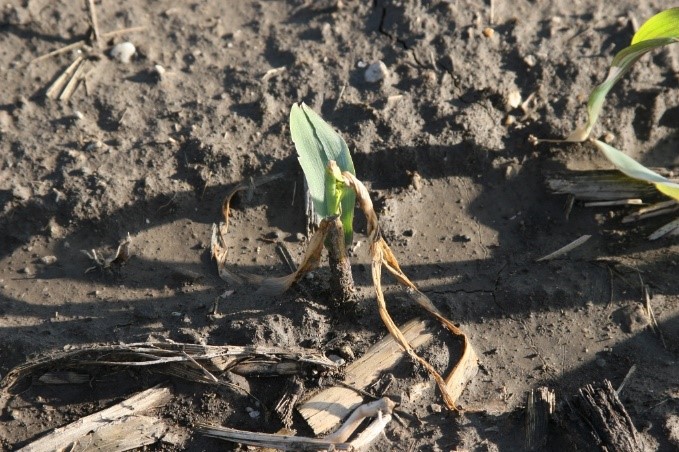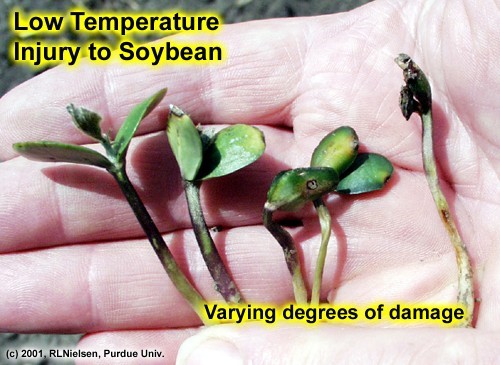
- Air temperatures at or below 28 °F can be fatal to corn and soybeans, depending on their duration and crop growth stage.
- Waiting a few days after the freeze or frost event to examine affected plants, is the best way to assess the extent of damage and make management decisions.
- Certain management practices such as herbicide applications, may need to be delayed when frost-freeze injury occurs.
Air temperatures at or below 28 °F for just a few hours can kill corn outright, even when the growing point is below ground, while air temperatures above 28 °F have a variable effect on young corn. For soybeans, when the air temperature drops below 28-32 °F, plants can experience some degree of frost damage. If the freeze period lasts for several hours and damage occurs below the cotyledons, soybeans can die. When light frost occurs, it typically shows up in bottom ground and lower parts of fields where the cold air has a chance to collect. It may also show up in fields protected by trees, since a light breeze can otherwise stir the air and prevent the cold air from collecting in one spot. Occasionally, frost injury is worse on high ground because this ground has better drainage and will lose stored heat faster than the moister lower ground. During still clear nights, exposed plants can rapidly give up their heat to the upper atmosphere, resulting in freeze injury to the plant tissue, even when recorded air temperatures are several degrees above freezing.
We often see tillage or soil moisture effects with frost. Light tillage or cultivation tends to open the soil to rapid heat loss. Dry soils also tend to rapidly give up stored heat. A thick layer of crop residue on the soil surface will insulate the soil. This sometimes prevents radiant heat from protecting the young corn as air temperatures drop. It is important to note that the net effect of variable terrain and soil conditions on the young corn can be drastically different, depending on the time and duration of the cold temperatures.
The plant growth stage at the time of freezing is also important in determining the extent of the damage. Minor frost injury on young corn plants typically has very little effect on yield. The growing point remains protected underground through growth stage V4. At V5 the growing point is right at ground level and by V6 it is above ground. Even after the growing point lifts above ground, it remains somewhat protected in the center of the rolled leaves. The growing point can be inspected by splitting the corn plant with a razor blade. A healthy growing point will appear firm. Dark or water-soaked tissue is a sign that the growing point may have been damaged and the field should be monitored closely for a couple of days to assess the level of damage. In soybeans the most vulnerable growth stage is the crook stage. If soybeans have not yet emerged at the time of freeze, no damage will occur. However, if a frost occurs while soybean crooks are exposed and the tissue below the cotyledons (hypocotyl) freezes, the result is likely plant death.
Frost injury is usually evident within two days or less following the frost event. Damaged leaf tissue on corn will initially appear pale, or water soaked, and flaccid. The damaged tissue will subsequently turn brown, or straw-colored (Image 1). If the frost was not of duration or intensity to kill the growing point, new leaves will emerge through the damage. Mowing damaged corn has not been shown to accelerate the recovery from frost injury and is not advised. In fact, mowing may introduce pathogens to freshly cut leaf tissue. Frosted soybean tissue appears water-soaked on the cotyledons and leaves, and hypocotyls turn brown within a few days of the frost event (Image 2). Assess the frost damage three to five days after the frost event to allow time for the soybeans to exhibit any signs of regrowth or recovery. If the soybeans appear soft and mushy, they will not recover and stand counts should be conducted to determine if replanting is necessary. For more information on replanting follow this link.
Postemergence applications of herbicides may need to be delayed following a frost. Injury to the crop may make it sensitive to the herbicide, while injury to weeds may make them tolerant to the herbicide. Affected fields should be evaluated carefully until the crop resumes normal growth and at least one new leaf collar is visible in corn and one or two new trifoliate leaflets are visible on soybeans.
Image 1. (above) Frosted Corn Plant Beginning to Show Signs of Recovery
Image 2. (below) Frost injury to soybeans. (Photo: RL Nielsen;Purdue University)